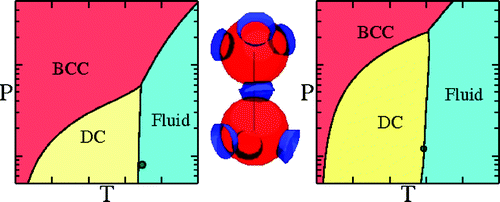Anisotropic particles with tetrahedral symmetry: Difference between revisions
Jump to navigation
Jump to search
No edit summary |
No edit summary |
||
| Line 1: | Line 1: | ||
The phase diagram of tetrahedral, patchy particles <ref>[http://dx.doi.org/10.1021/jp9081905 F. Romano, E. Sanz and F. Sciortino "Role of the Range in the Fluid−Crystal Coexistence for a | The phase diagram of tetrahedral, patchy particles <ref>[http://dx.doi.org/10.1021/jp9081905 F. Romano, E. Sanz and F. Sciortino "Role of the Range in the Fluid−Crystal Coexistence for a | ||
Patchy Particle Model", J. Phys. Chem. B '''113''' pp. 15133–15136 (2009)]</ref> | Patchy Particle Model", J. Phys. Chem. B '''113''' pp. 15133–15136 (2009)]</ref> | ||
exhibits the following solid phases: Diamond Crystal, | exhibits the following solid phases: Diamond Crystal (DC), | ||
Body Centered Cubic and Face Centered Cubic. The gas-liquid critical point becomes metastable with respect | Body Centered Cubic (BCC) and Face Centered Cubic (FCC). The gas-liquid critical point becomes metastable with respect | ||
to the Diamond Crystal when the range of the interaction becomes short (roughly less than 15% of the | to the Diamond Crystal when the range of the interaction becomes short (roughly less than 15% of the | ||
diameter). | diameter). | ||
[[Image:romanojpcb09.gif]] | [[Image:romanojpcb09.gif]] | ||
By contrast to isotropic models, the critical point | |||
has only a weak metastability | |||
with respect to the solid as the interaction range | |||
narrows (from left to right in the figure). | |||
---- | ---- | ||
Revision as of 18:24, 28 November 2009
The phase diagram of tetrahedral, patchy particles [1] exhibits the following solid phases: Diamond Crystal (DC), Body Centered Cubic (BCC) and Face Centered Cubic (FCC). The gas-liquid critical point becomes metastable with respect to the Diamond Crystal when the range of the interaction becomes short (roughly less than 15% of the diameter).
By contrast to isotropic models, the critical point has only a weak metastability with respect to the solid as the interaction range narrows (from left to right in the figure).
References
- ↑ [http://dx.doi.org/10.1021/jp9081905 F. Romano, E. Sanz and F. Sciortino "Role of the Range in the Fluid−Crystal Coexistence for a Patchy Particle Model", J. Phys. Chem. B 113 pp. 15133–15136 (2009)]
